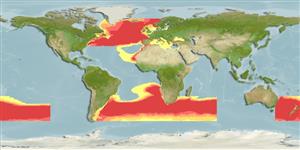Common names from other countries
Teleostei (teleosts) >
Scombriformes (Mackerels) >
Centrolophidae (Medusafishes)
Etymology: Centrolophus: Greek, kentron = sting + Greek, lophos = crest (Ref. 45335).
More on author: Gmelin.
Environment: milieu / climate zone / depth range / distribution range
Ecology
Marine; bathypelagic; depth range 40 - 1050 m (Ref. 52180), usually 300 - 700 m (Ref. 52180). Deep-water; 68°N - 55°S, 180°W - 180°E
North Atlantic: Nova Scotia and Grand Banks (Canada) to Massachusetts, USA (Ref. 7251). Also known from the Northeast Atlantic and the Mediterranean Sea. Southeast Atlantic and Indian Ocean: South Africa and Australia (including New South Wales). Southwest Pacific: New Zealand. Southern Ocean. Antitropical.
Size / Weight / Age
Maturity: Lm ? range ? - ? cm
Max length : 150 cm SL male/unsexed; (Ref. 4542); common length : 60.0 cm TL male/unsexed; (Ref. 3397)
An oceanic, epipelagic or mesopelagic species (Ref. 6942). Juveniles occurring in surface waters (Ref. 4542) and associated with pelagic medusas and salps (Ref. 4410), adults found deeper (Ref. 4542). May form small schools. Appears to feed on whatever is available, small fish, squid, large pelagic crustaceans, and other plankton (Ref. 4542).
Life cycle and mating behavior
Maturities | Reproduction | Spawnings | Egg(s) | Fecundities | Larvae
Haedrich, R.L., 1990. Centrolophidae. p. 1011-1013. In J.C. Quero, J.C. Hureau, C. Karrer, A. Post and L. Saldanha (eds.) Check-list of the fishes of the eastern tropical Atlantic (CLOFETA). JNICT, Lisbon; SEI, Paris; and UNESCO, Paris. Vol. 2. (Ref. 6942)
IUCN Red List Status (Ref. 130435)
CITES (Ref. 128078)
Not Evaluated
Threat to humans
Harmless
Human uses
Fisheries: of potential interest; gamefish: yes
Tools
Special reports
Download XML
Internet sources
Estimates based on models
Preferred temperature (Ref.
115969): 2.7 - 11.9, mean 7 (based on 632 cells).
Phylogenetic diversity index (Ref.
82804): PD
50 = 1.0000 [Uniqueness, from 0.5 = low to 2.0 = high].
Bayesian length-weight: a=0.00661 (0.00334 - 0.01306), b=3.09 (2.91 - 3.27), in cm Total Length, based on LWR estimates for this species & (Sub)family-body (Ref.
93245).
Trophic level (Ref.
69278): 3.9 ±0.38 se; based on food items.
Resilience (Ref.
120179): Very Low, minimum population doubling time more than 14 years (Preliminary K or Fecundity.).
Fishing Vulnerability (Ref.
59153): Very high vulnerability (90 of 100).
Climate Vulnerability (Ref.
125649): Moderate vulnerability (38 of 100).
